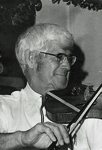 We
don't know nearly enough about Phil Cook, square dance fiddler and Mohawk
Indian originally from the Akwesasne Mohawk nation on the New York/Canadian
border. Cook represents an interesting
tradition that developed in the North Country starting in the first years of
European activity.
We
don't know nearly enough about Phil Cook, square dance fiddler and Mohawk
Indian originally from the Akwesasne Mohawk nation on the New York/Canadian
border. Cook represents an interesting
tradition that developed in the North Country starting in the first years of
European activity.
In his own words, taken from the only known recording of Cook’s dynamic fiddling:
“I come from the St Regis Mohawk Indian reservation, and when the Jesuit missionaries came among our people in 1565, they discouraged anything that the Indians did that was ‘Indian’ so to speak. They (the missionaries) tried to replace everything that they took away from them...they discouraged them from dancing Indian dances because the Indian dances had to do with their Indian religion and their government. So, they hired Scotch, French and English and Irish musicians to come among our people and play music and teach them to dance square dances, and I think that’s why that I’m playing the violin today. I learned from my Dad; it was a family of fiddlers. His father played the violin also, so I don’t know how ancient some of these tunes are, but that’s where they got them - they got them from the French, the English and the Scotch and the Irish people who immigrated and passed through that part of the country.”
By the early 1970s, and possibly long before, Cook had relocated to Washington State where Northwest musicians Vivian and Phil Williams had him record many of his tunes. According to Vivian Williams, “his backup was a good North Carolina traditional guitarist (Bill Pruett) who did not know how to back up jigs, but did fine on everything else. I believe Phil Cook was in his late 50's or early 60's when we made the recording, although I'm not sure about that.”
The three fiddle tunes below represent what Cook called “a first change, second change and a breakdown,” three pieces that would be played in succession for dancing in his Northern New York community. Dancers would take a break between each of the three pieces, but would keep the same partner until the entire three-song cycle was completed.
TUNES:


